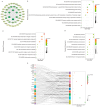Mechanism Actions of Coniferyl Alcohol in Improving Cardiac Dysfunction in Renovascular Hypertension Studied by Experimental Verification and Network Pharmacology
- PMID: 39337549
- PMCID: PMC11444148
- DOI: 10.3390/ijms251810063
Mechanism Actions of Coniferyl Alcohol in Improving Cardiac Dysfunction in Renovascular Hypertension Studied by Experimental Verification and Network Pharmacology
Abstract
Renovascular hypertension (RH), a secondary hypertension, can significantly impact heart health, resulting in heart damage and dysfunction, thereby elevating the risk of cardiovascular diseases. Coniferol (CA), which has vascular relaxation properties, is expected to be able to treat hypertension-related diseases. However, its potential effects on cardiac function after RH remain unclear. In this study, in combination with network pharmacology, the antihypertensive and cardioprotective effects of CA in a two-kidney, one-clip (2K1C) mice model and its ability to mitigate angiotensin II (Ang II)-induced hypertrophy in H9C2 cells were investigated. The findings revealed that CA effectively reduced blood pressure, myocardial tissue damage, and inflammation after RH. The possible targets of CA for RH treatment were screened by network pharmacology. The interleukin-17 (IL-17) and tumor necrosis factor (TNF) signaling pathways were identified using a Kyoto Encyclopedia of Genes and Genomes (KEGG) enrichment analysis. The inflammatory response was identified using a Gene Ontology (GO) enrichment analysis. Western blot analysis confirmed that CA reduced the expression of IL-17, matrix metallopeptidase 9 (MMP9), cyclooxygenase 2 (COX2), and TNF α in heart tissues and the H9C2 cells. In summary, CA inhibited cardiac inflammation and fibrohypertrophy following RH. This effect was closely linked to the expression of MMP9/COX2/TNF α/IL-17. This study sheds light on the therapeutic potential of CA for treating RH-induced myocardial hypertrophy and provides insights into its underlying mechanisms, positioning CA as a promising candidate for future drug development.
Keywords: MMP9/COX2/TNF α/IL-17; coniferyl alcohol; inflammatory response; myocardial hypertrophy; network pharmacology; renovascular hypertension.
Conflict of interest statement
The authors declare that they have no known competing financial interests or personal relationships.
Figures










Similar articles
-
2K1C-activated Angiotensin II (Ang II) exacerbates vascular damage in a rat model of arthritis through the ATR/ERK1/2 signaling pathway.Inflamm Res. 2017 Oct;66(10):881-890. doi: 10.1007/s00011-017-1069-8. Epub 2017 Jun 26. Inflamm Res. 2017. PMID: 28653218
-
TNF-α inhibition decreases MMP-2 activity, reactive oxygen species formation and improves hypertensive vascular hypertrophy independent of its effects on blood pressure.Biochem Pharmacol. 2020 Oct;180:114121. doi: 10.1016/j.bcp.2020.114121. Epub 2020 Jun 25. Biochem Pharmacol. 2020. PMID: 32592722
-
JinLiDa granules alleviates cardiac hypertrophy and inflammation in diabetic cardiomyopathy by regulating TP53.Phytomedicine. 2024 Jul 25;130:155659. doi: 10.1016/j.phymed.2024.155659. Epub 2024 May 10. Phytomedicine. 2024. PMID: 38759318
-
Uncovering the action mechanism of Shenqi Tiaoshen formula in the treatment of chronic obstructive pulmonary disease through network pharmacology, molecular docking, and experimental verification.J Tradit Chin Med. 2024 Aug;44(4):770-783. doi: 10.19852/j.cnki.jtcm.20240610.002. J Tradit Chin Med. 2024. PMID: 39066538 Free PMC article.
-
Endothelial CHOP as a central mechanism in renovascular hypertension-induced vascular endothelial dysfunction and cardiac fibrosis.Cell Mol Life Sci. 2025 Jun 13;82(1):232. doi: 10.1007/s00018-025-05741-6. Cell Mol Life Sci. 2025. PMID: 40512182 Free PMC article.
References
-
- Murray C.J.L., Aravkin A.Y., Zheng P., Abbafati C., Abbas K.M., Abbasi-Kangevari M. Global burden of 87 risk factors in 204 countries and territories, 1990–2019: A systematic analysis for the Global Burden of Disease Study 2019. Lancet. 2020;396:1223–1249. doi: 10.1016/S0140-6736(20)30752-2. - DOI - PMC - PubMed
-
- Poasakate A., Maneesai P., Potue P., Bunbupha S., Tong-Un T., Settheetham-Ishida W., Khamseekaew J., Pakdeechote P. Genistein alleviates renin-angiotensin system mediated vascular and kidney alterations in renovascular hypertensive rats. Biomed. Pharmacother. 2022;146:112601. doi: 10.1016/j.biopha.2021.112601. - DOI - PubMed
-
- Rizzoni D., Muiesan M.L., Porteri E., Salvetti M., Castellano M., Bettoni G., Tiberio G., Giulini S.M., Monteduro C., Garavelli G., et al. Relations between cardiac and vascular structure in patients with primary and secondary hypertension. J. Am. Coll. Cardiol. 1998;32:985–992. doi: 10.1016/S0735-1097(98)00322-2. - DOI - PubMed
MeSH terms
Substances
Grants and funding
- No. HXYS19001, HXYS19002/the Innovative Chinese Medicine and Health Products Research Academician Workstation of Academicians Boli Zhang and Beiwei Zhu of the West China Hospital, Sichuan University
- No. ZYXY21002/the 135 Project for Disciplines of Excellence, West China Hospital, Sichuan University
- No. 161200012/the Innovative Chinese Medicine Preclinical Research Fund of "Liqing No.2", West China Hospital, Sichuan University
LinkOut - more resources
Full Text Sources
Research Materials
Miscellaneous

